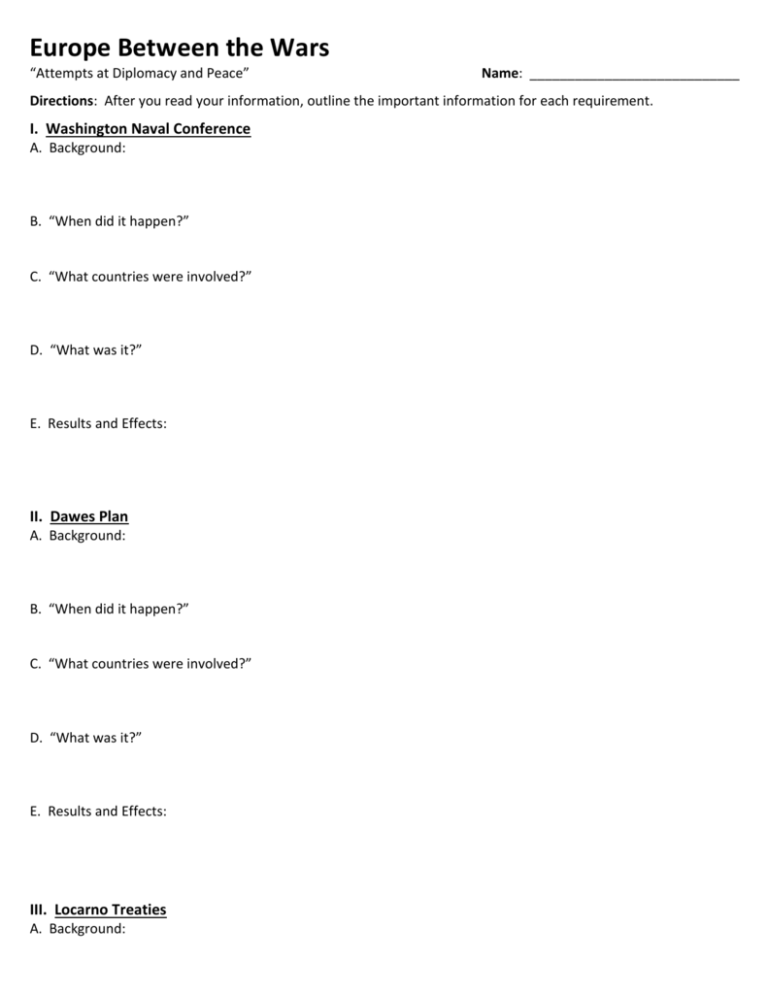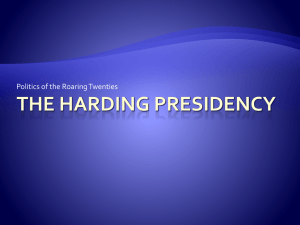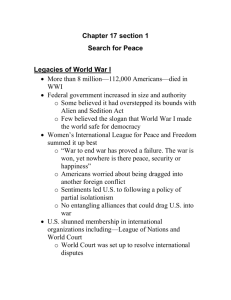I. Washington Naval Conference
advertisement

Europe Between the Wars “Attempts at Diplomacy and Peace” Name: ____________________________ Directions: After you read your information, outline the important information for each requirement. I. Washington Naval Conference A. Background: B. “When did it happen?” C. “What countries were involved?” D. “What was it?” E. Results and Effects: II. Dawes Plan A. Background: B. “When did it happen?” C. “What countries were involved?” D. “What was it?” E. Results and Effects: III. Locarno Treaties A. Background: B. “When did it happen?” C. “What countries were involved?” D. “What was it?” E. Results and Effects: IV. Kellogg-Briand Pact A. Background: B. “When did it happen?” C. “What countries were involved?” D. “What was it?” E. Results and Effects: The Washington Naval Conference Between November 1921 and February 1922, the world’s largest naval powers gathered in Washington for a conference to discuss naval disarmament and ways to relieve growing tensions in East Asia. In the wake of World War I, leaders in the international community sought to prevent the possibility of another war. Rising Japanese militarism and an international arms race heightened these concerns and policymakers worked to reduce the threat. Senator William E. Borah (R–Idaho) led a Congressional effort to demand that the United States engage its two principle competitors in the naval arms race, Japan and Britain, in negotiations for disarmament. At the end of the Great War, Britain still had the largest navy afloat but its big ships were becoming out-of-date, and the Americans and Japanese were rapidly building expensive new warships. Britain and Japan were allies in a treaty that was due to expire in 1922. Although there were no immediate dangers, observers increasingly pointed to the American-Japanese rivalry for control of the Pacific Ocean as a long-term threat to world peace. By this time, the British realized it had best join forces with Washington rather than Tokyo. To stop a needless, expensive and possibly dangerous arms race, the major countries signed a series of naval disarmament agreements. In 1921, U.S. Secretary of State Charles Evans Hughes invited nine nations to Washington to discuss naval reductions and the situation in the Far East. Great Britain, Japan, France and Italy were invited to take part in talks on reduction of naval capacity, and Belgium, China, the Netherlands and Portugal were invited to join in discussions on the situation in the Far East. Three major treaties emerged out of the Washington Conference: the Five-Power Treaty, the Four-Power Treaty, and the Nine-Power Treaty. The American delegation at the Washington Conference, led by Secretary of State Charles Evans Hughes, included Elihu Root and Henry Cabot Lodge. The primary objective of the conference was to restrain Japanese naval expansion in the waters of the west Pacific, especially with regard to fortifications on strategically valuable islands. Their secondary objectives were intended to ultimately limit Japanese expansion, but also to alleviate concerns over possible antagonism with the British. They were: first, to eliminate Anglo-American tension by abrogating the Anglo-Japanese alliance; second, to agree upon a favorable naval ratio regarding Japan; and, third, to have the Japanese officially accept a continuation of the Open Door Policy in China. The Five-Power treaty, signed by the United States, Great Britain, Japan, France and Italy was the cornerstone of the naval disarmament program. It called for each of the countries involved to maintain a set ratio of warship tonnage which allowed the United States and Britain 500,000 tons, Japan 300,000 tons and France and Italy each 175,000 tons. Though Japan preferred that tonnage be allotted at a 10:10:7 ratio, and the U.S. Navy preferred a 10:10:5 ratio, the conference ultimately adopted 5:5:3 limits. The key reason why the United States and Britain required higher tonnage allowances was because both nations maintained two-ocean navies: they were active in both the Atlantic and the Pacific, with colonial territories scattered around the world. Finally, this agreement called on signatories to stop building capital ships and reduce the size of their navies by scrapping older ships. Although the Five-Power Treaty controlled tonnage of each navy’s warships, some classes of ships were left unrestricted. As a result, a new race to build cruiser ships emerged after 1922, leading the powers back to the negotiating table in 1927 and 1930 to close the remaining loopholes in the agreements. In the Four-Power Treaty, the United States, France, Britain, and Japan agreed to consult with each other in the event of a future crisis in East Asia before taking action. This treaty replaced the Anglo-Japanese Treaty of 1902, which had been a source of some concern for the United States. In the years following World War I, U.S. policymakers saw Japan as the greatest rising military threat. Heavily militarized and looking to expand its influence and territory, Japan had the potential to threaten U.S. colonial possessions in Asia and the profitable China trade. Because of the 1902 agreement between Britain and Japan, however, if the United States and Japan entered into a conflict, Britain might be obligated to join Japan against the United States. By ending that treaty and creating a Four-Power agreement, the countries involved ensured that none would be obligated to engage in a conflict, but a mechanism would exist for discussions if one emerged. The final multilateral agreement made at the Washington Naval Conference was the Nine-Power Treaty, which marked the internationalization of the U.S. Open Door Policy in China. The treaty promised that each of the signatories – the United States, Britain, Japan, France, Italy, Belgium, the Netherlands, Portugal and China – would respect the territorial integrity of China. The treaty recognized Japanese dominance in Manchuria but otherwise affirmed the importance of equal opportunity for all nations doing business in the country; for its part, China promised not to discriminate against any country seeking to do business there. Like the Four-Power Treaty, the treaty on China called for consultations in the event of a violation instead of tying the signatories to a particular response. As a result, it lacked a method of enforcement to ensure that all powers abided by its terms. In addition to the multilateral agreements, several bilateral treaties were completed at the conference. Japan and China also signed a bilateral agreement, the Shangtung (Shandong) Treaty, which returned control of that province and its railroad to China. Japan had taken control of the area from the Germans during World War I, and then it maintained control over the years that followed. The combination of the Shangtung Treaty and the Nine-Power Treaty was meant to reassure China that its territory would not be further compromised by Japanese expansion. Additionally, Japan agreed to withdraw its troops from Siberia and the United States and Japan formed agreement over equal access to cable and radio facilities on the Japanese-controlled island of Yap. Together, the treaties signed at the Washington Conference served to uphold the status quo in the Pacific: they recognized existing interests and did not make fundamental changes to them. At the same time, the United States secured agreements that reinforced its existing policy in the Pacific, including the Open Door in China and the protection of the Philippines, while limiting the scope of Japanese imperial expansion as much as possible. The Dawes Plan In the years following the First World War, issues of debt repayment and reparations troubled relations between the Allies and the now defeated Germany. The American-sponsored Dawes and Young Plans offered a possible solution to these challenges. At the end of the First World War, the victorious European powers demanded that Germany compensate them for the devastation wrought by the four-year conflict, for which they held Germany and its allies responsible. Unable to agree upon the amount that Germany should pay at the Paris Peace Conference in 1919, the United States, the United Kingdom, France, and the other Allies established a Reparation Commission to settle the question. In the spring of 1921, the Commission set the final bill at 132 billion gold marks, approximately $31.5 billion. When Germany defaulted on a payment in January 1923, France and Belgium occupied the Ruhr in an effort to make it pay; instead, they met a government-backed campaign of passive resistance. Inflation in Germany, which had begun to accelerate in 1922, spiraled into hyperinflation. The value of the German currency collapsed; the battle over reparations had reached an impasse. Meanwhile, a second wartime financial issue was causing tension among the former co-belligerents. While the United States had little interest in collecting reparations from Germany, it was determined to secure repayment of the more than $10 billion it had loaned to the Allies over the course of the war. Time and again, Washington rejected calls to cancel these debts in the name of the common wartime cause; it also resisted efforts to link reparations to inter-allied war debts. In 1922, London made this link explicit in the Balfour Note, which stated that it would seek reparations and wartime debt repayments from its European allies equal to its debt to the United States. That same year, Congress created the United States War Debt Commission to negotiate repayment plans, on concessionary terms, with the 17 countries that had borrowed money from the United States. In late 1923, with the European powers stalemated over German reparations, the Reparation Commission created a committee to review the situation. Headed by Charles G. Dawes (Chicago banker, former Director of the Bureau of the Budget, and future Vice President), the committee presented its proposal in April 1924. Under the Dawes Plan, Germany’s annual reparation payments would be reduced, increasing over time as its economy improved; the full amount to be paid, however, was left undetermined. Economic policy making in Berlin would be reorganized under foreign supervision and a new currency, the Reichsmark, adopted. France and Belgium would evacuate the Ruhr and foreign banks would loan the German government $200 million to help encourage economic stabilization. American financier J. P. Morgan floated the loan on the U.S. market, which was quickly oversubscribed. Over the next four years, U.S. banks continued to lend Germany enough money to enable it to meet its reparation payments to countries such as France and the United Kingdom. These countries, in turn, used their reparation payments from Germany to service their war debts to the United States. In 1925, Dawes was a corecipient of the Nobel Peace Prize in recognition of his plan’s contribution to the resolution of the crisis over reparations. In the autumn of 1928, another committee of experts was formed, this one to devise a final settlement of the German reparations problem. In 1929, the committee, under the chairmanship of Owen D. Young, the head of General Electric and a member of the Dawes committee, proposed a plan that reduced the total amount of reparations demanded of Germany to 121 billion gold marks, almost $29 billion, payable over 58 years. Another loan would be floated in foreign markets, this one totaling $300 million. Foreign supervision of German finances would cease and the last of the occupying troops would leave German soil. The Young Plan also called for the establishment of a Bank for International Settlements, designed to facilitate the payment of reparations. The advent of the Great Depression doomed the Young Plan from the start. Loans from U.S. banks had helped prop up the German economy until 1928; when these loans dried up, Germany’s economy floundered. In 1931, as the world sunk ever deeper into depression, a one-year moratorium (suspension, or freeze) on all debt and reparation payments was declared at the request of President Herbert Hoover; an effort to renew the moratorium the following year failed. At the Lausanne Conference in 1932, European nations agreed to cancel their reparation claims against Germany, save for a final payment. After the November 1932 election of Franklin D. Roosevelt, France and the United Kingdom resurrected the link between reparations and war debts, tying their Lausanne Conference pledge to cancel their claims against Germany to the cancellation of their debts to the United States. The United States would not accept the proposal. By mid-1933, all European debtor nations except Finland had defaulted on their loans from the United States. Nevertheless, the Dawes and Young Plans were important U.S. efforts that had lasting consequences. Coming so soon after the American rejection of the Treaty of Versailles and the League of Nations, the Dawes and Young Plans were significant instances of U.S. re-engagement with European affairs. Locarno Treaties The discussion at Locarno, Switzerland arose from exchanges between the British Empire, France and Germany throughout the summer of 1925 following German Foreign Minister Gustav Stresemann's proposal for a reciprocal of his country's western frontiers as established under the Treaty of Versailles, as a means of facilitating Germany's diplomatic rehabilitation among the Western Powers. At least one of the main reasons Britain promoted the Locarno Pact of 1925, besides to promote Franco-German reconciliation, was because of the understanding that if Franco-German relations improved, France would gradually abandon its alliance system in Eastern Europe that it developed in the early 1920s. Once France had abandoned its allies in Eastern Europe, thereby creating a situation where the Poles and Czechoslovaks having no Great Power to protect them from Germany, would be forced to adjust to German demands, and hence in the British viewpoint would peacefully hand over the territories claimed by Germany such as the Sudetenland, the Polish Corridor, and the Free City of Danzig (modern Gdańsk, Poland). In this way, promoting territorial revisionism in Eastern Europe in Germany’s favor was one of the principal British objects of Locarno, making Locarno an early instance of appeasement. The principal treaty concluded at Locarno was the “Rhineland Pact” between Germany, France, Belgium, the United Kingdom and Italy. The first three signatories undertook not to attack each other, with the latter two acting as guarantors. In the event of aggression by any of the first three states against another, all other parties were to assist the country under attack. Germany also agreed to sign arbitration conventions with France and Belgium and arbitration treaties with Poland and Czechoslovakia, undertaking to refer disputes to an arbitration tribunal or to the Permanent Court of International Justice. France signed further treaties with Poland and Czechoslovakia, pledging mutual assistance in the event of conflict with Germany. The Locarno Treaties were regarded as the keystone of the improved western European diplomatic climate of 1924–1930, introducing a hope for international peace, typically called the “spirit of Locarno.” This spirit was seen in Germany's admission to the League of Nations, the international organization established under the Versailles treaty to promote world peace and co-operation, and in the subsequent withdrawal (completed in June 1930) of Allied troops from Germany's western Rhineland. In contrast, Locarno contributed to the worsening of the atmosphere between Poland and France (despite the French-Polish alliance), and introduced distrust between Poland and Western countries. Locarno divided borders in Europe in two categories: those guaranteed by Locarno, and others, which were free for revision. One notable exception from the Locarno arrangements was, however, the Soviet Union, which foresaw western cooperation as potentially deepening its own political isolation in Europe, in particular by detaching Germany from its own understanding with Moscow under the 1922 Treaty of Rapallo (both sides renounced all territorial and financial claims against the other following the Treaty of Brest-Litovsk). Political tensions also continued throughout the period in eastern Europe. In 1933, Adolf Hitler came to power; his practice was to conduct bilateral, not multilateral, negotiations. Proposals in 1934 for an “eastern Locarno” pact securing Germany's eastern frontiers failed due to German opposition and on Poland's insistence that its eastern borders should be covered by a western guarantee of her borders. Germany formally repudiated its Locarno undertakings by sending troops into the demilitarized Rhineland in March 1936. Kellogg-Briand Pact The Kellogg-Briand Pact was an agreement to outlaw war signed on August 27, 1928. Sometimes called the Pact of Paris for the city in which it was signed, the pact was one of many international efforts to prevent another World War, but it had little effect in stopping the rising militarism of the 1930s or preventing World War II. In the wake of World War I, U.S. officials and private citizens made significant efforts to guarantee that the nation would not be drawn into another war. Some focused on disarmament, such as the series of naval conferences that began in Washington in 1921, and some focused on cooperation with the League of Nations and the newly formed World Court. Others initiated a movement to try to outlaw war outright. Peace advocates Nicholas Murray Butler and James T. Shotwell were part of this movement. Both men were affiliated with the Carnegie Endowment for International Peace, an organization dedicated to promoting internationalism that was established in 1910 by leading American industrialist Andrew Carnegie. With the influence and assistance of Shotwell and Butler, French Minister of Foreign Affairs Aristide Briand proposed a peace pact as a bilateral agreement between the United States and France to outlaw war between them. Particularly hard hit by World War I, France faced continuing insecurity from its German neighbor and sought alliances to shore up its defenses. Briand published an open letter in April of 1927 containing the proposal. Though the suggestion had the enthusiastic support of some members of the American peace movement, U.S. President Calvin Coolidge and Secretary of State Frank B. Kellogg were less eager than Briand to enter into a bilateral arrangement. They worried that the agreement against war could be interpreted as a bilateral alliance and require the United States to intervene if France was ever threatened. To avoid this, they suggested that the two nations take the lead in inviting all nations to join them in outlawing war. The extension of the pact to include other nations was well-received internationally. After the severe losses of the First World War, the idea of declaring war to be illegal was immensely popular in international public opinion. Because the language of the pact established the important point that only wars of aggression – not military acts of self-defense – would be covered under the pact, many nations had no objections to signing it. If the pact served to limit conflicts, then everyone would benefit; if it did not, there were no legal consequences. In early 1928, negotiations over the agreement expanded to include all of the initial signatories. In the final version of the pact, they agreed upon two clauses: the first outlawed war as an instrument of national policy and the second called upon signatories to settle their disputes by peaceful means. On August 27, 1928, fifteen nations signed the pact at Paris. Signatories included France, the United States, the United Kingdom, Ireland, Canada, Australia, New Zealand, South Africa, India, Belgium, Poland, Czechoslovakia, Germany, Italy and Japan. Later, an additional forty-seven nations followed suit, so the pact was eventually signed by most of the established nations in the world. The U.S. Senate ratified the agreement by a vote of 85–1, though it did so only after making reservations to note that U.S. participation did not limit its right to self-defense or require it to act against signatories breaking the agreement The first major test of the pact came just a few years later in 1931, when the Mukden Incident led to the Japanese invasion of Manchuria. Though Japan had signed the pact, the combination of the worldwide depression and a limited desire to go to war to preserve China prevented the League of Nations or the United States from taking any action to enforce it. Further threats to the Peace Agreement also came from fellow signatories Germany, Austria and Italy. It soon became clear that there was no way to enforce the pact or sanction those who broke it; it also never fully defined what constituted “self-defense,” so there were many ways around its terms. In the end, the Kellogg-Briand Pact did little to prevent World War II or any of the conflicts that followed. Its legacy remains as a statement of the idealism expressed by advocates for peace in the interwar period. Frank Kellogg earned the Nobel Peace Prize in 1929 for his work on the Peace Pact.







